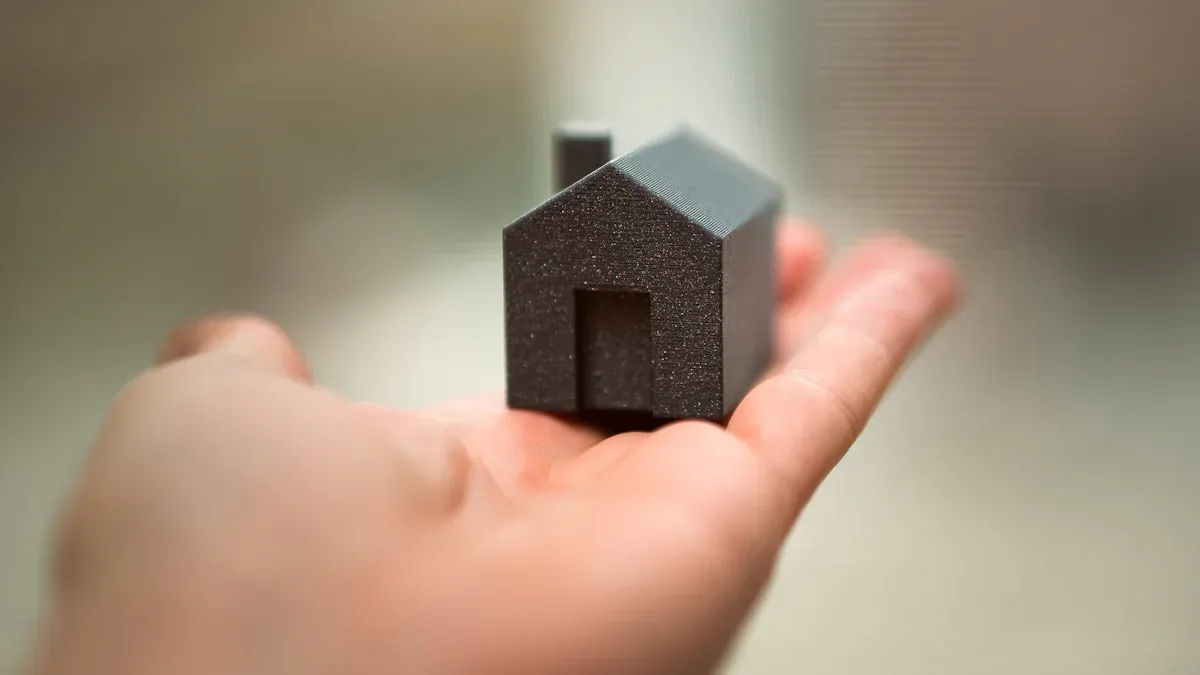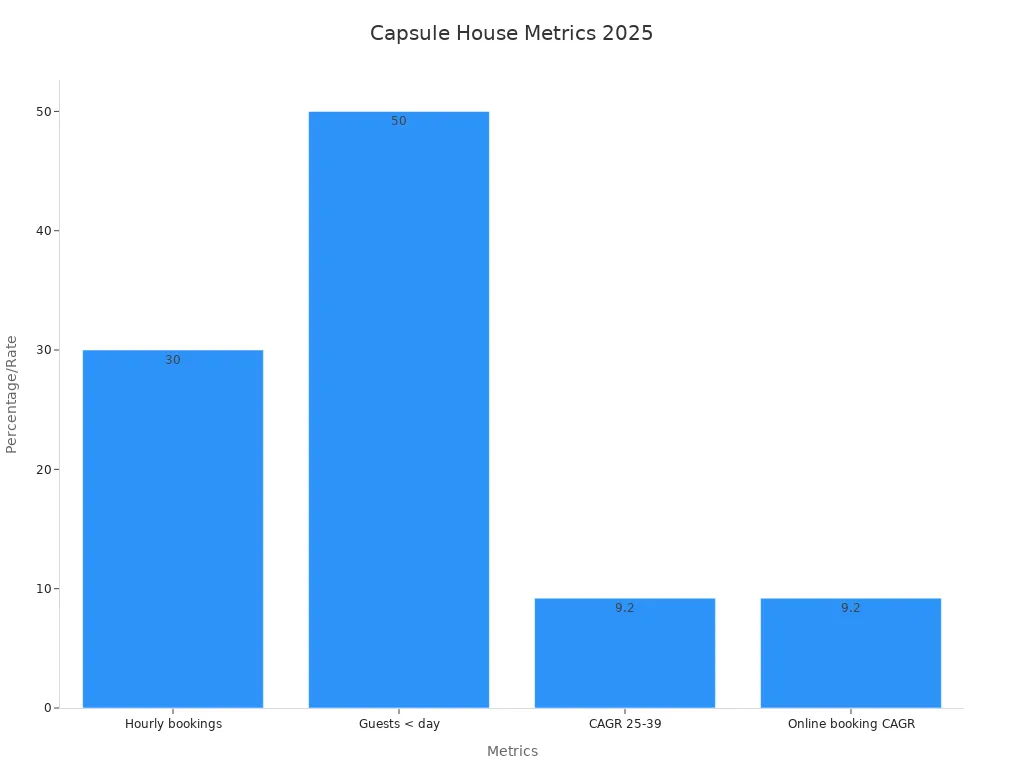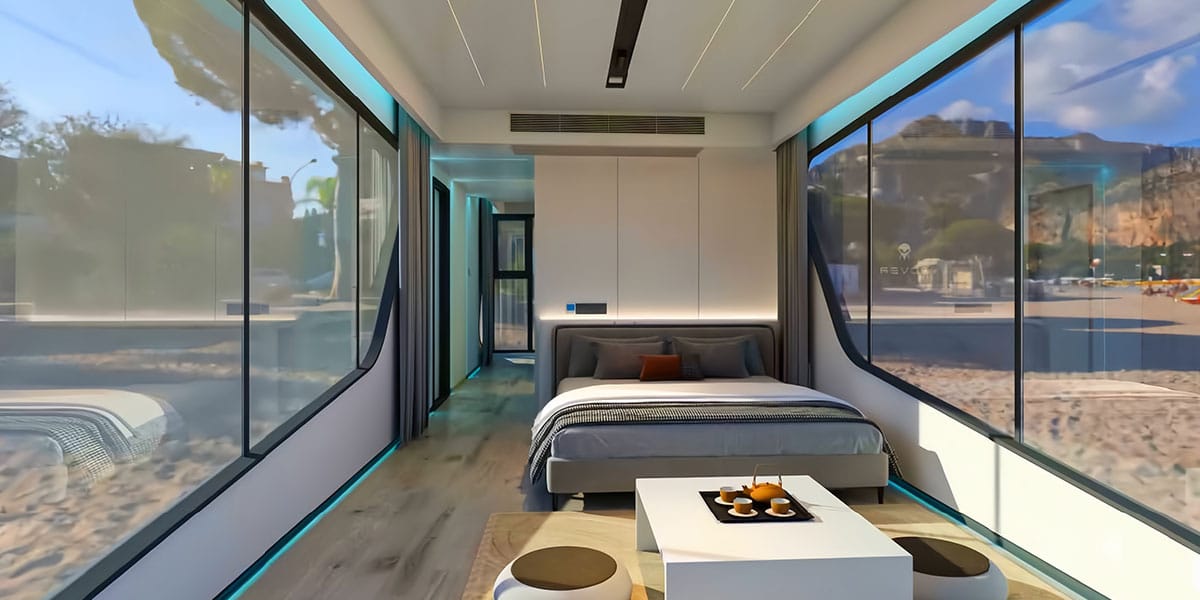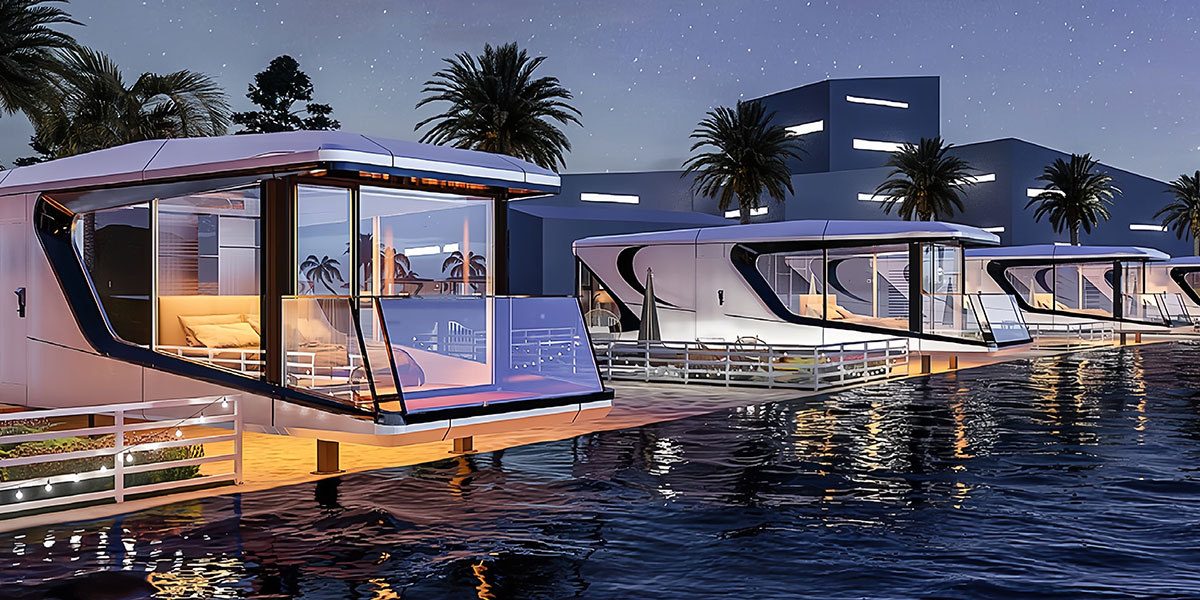
18 Jul Top Capsule House Trends Shaping Modern Lifestyles in 2025
Table of Contents
Capsule house popularity keeps rising in 2025. This is because of new designs, low prices, and green features. Many young adults and solo travelers like capsule houses. They enjoy the small size and modern look. The market is growing fast, as you can see in the chart below.
Eco-friendly materials help lower carbon footprints. Modular layouts let people use space in many ways. These trends make capsule houses very popular. People want homes that are green and work well in cities.
Key Takeaways
Capsule houses have clever designs and use modular parts to save space. They can meet many different needs. They cost less than normal homes. People can save money on energy bills. Eco-friendly materials and green energy help the planet. Smart technology in capsule homes makes them more comfortable and safe. It also helps save energy. Capsule houses give people flexible and cheap places to live. They are good for people with busy city lives.
Capsule House Overview
What Is a Capsule House
A capsule house is a small home made for comfort and smart use of space. These homes have clever layouts to use every bit of room. People often think capsule houses are like tiny homes. But capsule houses focus more on being easy to build and change. Many have furniture built into the walls. Some beds can fold up, and storage is hidden. This helps people live well in small places. Students, travelers, and city workers like capsule houses. They want homes that cost less and can change with their needs.
Capsule houses started in Japan. Later, they spread to other countries. People wanted new ways to live in crowded cities. Now, capsule houses use new materials and technology. They are safe and look nice. Many have green features like solar panels and recycled parts.

2025 Market Growth
The capsule house market has grown each year. Looking at old market data helps experts see how things change. By checking market size and growth, builders and investors find new chances. They also get ready for problems. The market grew because people wanted cheaper and flexible homes.
In 2025, the capsule house market keeps getting bigger. The table below shows how related markets are growing. This shows more people want small homes:
Market Segment | Year | Market Size (USD) | CAGR (%) | Notes on Growth Compared to Previous Years |
|---|---|---|---|---|
Coffee Pods & Capsules Market | 2024 | 28.51 billion | N/A | Market size before 2025 |
Coffee Pods & Capsules Market | 2025 | 30.63 billion | 6.91 | Projected market size and CAGR from 2025 to 2030 |
Empty Capsules Market | 2024 | 3.44 billion | N/A | Baseline before forecast period |
Empty Capsules Market | 2025-2032 | N/A | 6.7 | Steady growth projected post-pandemic |
These numbers show more people want green and low-cost homes. Builders use new tools and materials to help. Capsule houses are now important for city life.
Capsule House Design Trends
Space Efficiency
Capsule homes in 2025 use space very well. Designers try to make every part useful. New capsule house models are 10.5 feet wide. This is wider than most container tiny homes. The extra width gives people more space to move. The standing height is almost 8 feet. Most people can stand up straight inside. Prefabricated designs help build homes fast, sometimes in one day.
Many capsule homes have Murphy beds and foldable furniture. These let people change sleeping areas into living or work spaces. Smart home systems control lights and temperature. This helps small spaces feel bigger. Noise insulation is better now. It blocks over 55 decibels of outside sound. This makes homes quiet and private.
Feature/Improvement | Description/Measurement |
|---|---|
Dimensions | 10.5 feet wide and tall, more space than standard container homes |
Multifunctional Furnishings | Foldable and hidden furniture increases usable space |
Modular Construction | Customizable layouts for different needs |
Murphy Beds | Fold-away beds free up living area |
Smart Building Systems | Automated controls for comfort and efficiency |
Durable Materials | Lightweight panels and insulation increase usable interior space |
Energy Efficiency | Advanced insulation reduces need for bulky heating and cooling systems |
Modularity
Modularity is a big trend in capsule house design for 2025. Capsule homes use modular construction for easy changes. People can add or remove sections as needed. This helps families, students, and workers change their space as life changes.
Modular layouts make building faster and cut down on waste. Prefabricated parts come ready to put together. This saves time and money. Many capsule homes let buyers pick layouts, finishes, and materials. This helps people get a home that fits their style. Cities like modular capsule homes because they solve space and cost problems.
- Modular and prefabricated construction lowers costs and waste.
- Customization options let people pick layouts, materials, and finishes.
- Urban housing challenges drive demand for compact, affordable capsule homes.
- Government support in some countries helps modular capsule housing projects grow.
- Young people like capsule homes for their style, price, and eco-friendly features.
Eco-Friendly Materials
Sustainable capsule houses use eco-friendly materials. Builders pick recycled wood, steel, and plastics to help the planet. Many capsule homes use magnesium oxide boards. These boards resist fire, pests, and mold. They pass tough tests for safety and strength, like ASTM E119 and ASTM E84.
Designers use low-VOC paints and sealants for better air. Water-saving fixtures, rainwater harvesting, and graywater recycling save water. Modular building uses only what is needed, so there is less waste. Using local materials means less pollution from trucks. These steps make capsule houses better for people and nature.
Metric / Test | What It Measures |
|---|---|
Durability and Impact Tests | Strength and long-term reliability of materials |
ASTM E119 | Fire resistance and structural integrity |
ASTM E84 | Flame spread rate |
Pest and Mold Resistance | Natural resistance without chemicals |
Life Cycle Assessment (LCA) | Environmental impact from production to disposal |
- Recycled and reclaimed materials reduce environmental harm.
- Local sourcing and modular building lower emissions and waste.
- Water conservation systems support eco-friendly living.
Smart Technology
Smart technology is important for capsule homes. In 2025, most capsule houses have smart thermostats, voice-activated lights, and security systems. These features make life easier and safer. People can use phones or voice commands to control lights, locks, and temperature.
Smart home systems help save energy. Automated climate control keeps the home comfy and uses less power. Energy monitoring tools show how much power is used and help save money. Many capsule homes use triple-layer glass and strong insulation. This keeps heat in and noise out. Builders use strong materials like aluminum shells and steel frames for these smart features.
Feature | Benefit |
|---|---|
Automated Climate Control | Keeps temperature comfortable automatically |
Easy control of lights and locks | |
Energy Monitoring | Tracks and reduces energy use |
Automated Lighting | Saves energy and sets the mood |
Smart Appliances | Makes chores easier |
Remote Monitoring | Improves home security |
Smart technology in capsule homes saves energy and makes life easier. It also keeps people safe. These features make capsule houses popular with modern buyers.
Tip: Many capsule homes now have mobile apps. You can use these apps to control all smart features. This makes living in a small space even more comfortable.
Lifestyle Impact
 Affordability
Affordability
Capsule homes help people save money. They cost much less than regular houses. Most capsule homes cost between $20,000 and $100,000. Regular houses often cost about $300,000. Many young workers and students pick capsule homes. They want cheap places to live in cities. These homes use less energy and have green features. Solar panels and good appliances help lower bills. Some government programs give tax breaks for green homes. This makes capsule homes even cheaper. More companies are building capsule homes now. Prices are going down and designs are getting better.
- Capsule homes have all the main living spaces in a small area.
- Energy-saving systems help people pay less each month.
- Capsule hotels are very popular because they are cheap and small.
Urban Living
Capsule homes help fix housing problems in busy cities. They use less land and fit in crowded places. City planners like capsule homes because they add more homes fast. They also cost less to build. Cities like Shanghai and Guangzhou use capsule homes for many things. They work for mixed-use buildings and short-term housing. Many capsule homes have shared spaces. These help people meet and talk to neighbors. Capsule homes also support the 15-minute city idea. People can get to work, school, and stores quickly.
Modular building lets people build homes fast.
Green materials help cities reach their eco goals.
Shared spaces help people feel like part of a group.
Flexibility
People living in capsule homes can change their space easily. Modular layouts let people move walls or add rooms. Some capsule homes let you add or take away sections. This helps families, students, and workers as their needs change. Smart home tech and special furniture make it easy to switch uses. You can work, rest, or play in the same space. Capsule homes can move to new places or help during emergencies.
Tip: Many capsule homes have smart systems. These systems change lights and temperature to save energy and keep you comfy.
Minimalism
Capsule homes help people live with less stuff. People only keep what they need. This keeps their homes neat and tidy. Living in a small space teaches people to care about quality. They focus on doing things, not owning things. This way of living is good for the planet. It cuts down on waste and saves energy.
Benefit of Minimalism | How Capsule Homes Support It |
|---|---|
Less clutter | Built-in storage and simple layouts |
Lower costs | Fewer items to buy and maintain |
Eco-friendly | Reduced waste and energy consumption |
Capsule Homes Technology
Smart Features
Capsule homes in 2025 have smart features that help people. Many homes have lights you can turn on with your voice. They also have smart locks and systems to control the temperature. People use their phones or tablets to manage these things. Some homes have sensors that change lights and heat during the day. These smart systems save energy and keep homes comfy. Security cameras and alarms help keep people safe. Smart appliances like fridges and washers use less power and water. These features make capsule homes special in cities.
Renewable Energy
Many capsule homes use renewable energy to save money and help the planet. Solar panels and wind turbines give clean power for daily life. Some capsule homes, like the Ecocapsule and Ecocapsule Box, use both solar and wind. These homes can work without city power and store extra energy in batteries. The table below shows how these homes use renewable energy:
Model | Renewable Energy Sources | Energy Generation Capacity | Battery Storage Capacity | Description |
|---|---|---|---|---|
Ecocapsule | Solar panels, wind turbine | Up to 2.8 kWp | 28.8 kWh | Off-grid mobile home enabling self-sufficient living in remote locations. |
Ecocapsule Box | High-efficiency solar panels | 9 kWp | 25.6 kWh | Larger modular unit for permanent off-grid living, energy-efficient with smart home technology. |
Sustainable capsule houses use these systems to make less pollution. Many capsule homes also have energy-saving appliances and LED lights. These choices help people live in a greener way.
Prefabrication
Prefabrication helps build capsule homes fast and lets them move easily. Factories make the parts before sending them to where the home will be. Workers put the parts together quickly at the site. This way costs less and makes less waste. Many capsule homes use 3D printing for strong walls and floors. Advanced systems help these homes last long and stay safe in storms or earthquakes. Prefabrication lets people pick different layouts and finishes. This makes capsule homes a good choice for many people. Sustainable capsule houses often use prefabricated parts to help the environment.
Note: Prefabricated capsule homes can be ready in just a few days. This helps people get homes fast after disasters or when cities grow quickly.
Capsule House Applications
Glamping and Eco-Resorts:
Capsule houses are becoming increasingly popular in resorts and hotels, offering unique, sustainable, and luxurious accommodations.
Travel and Tourism:
They offer unique accommodation experiences in scenic locations, attracting tourists interested in glamping and eco-tourism.
Emporary Housing:
Capsule houses can be quickly deployed for emergency situations like natural disasters, providing shelter for displaced populations.
Mobile Offices:
These structures can be used as flexible workspaces, adaptable to various locations and needs.
Education and Training:
Capsule houses can serve as temporary classrooms or training facilities, offering a comfortable and efficient learning environment.
Retail and Exhibitions:
They can be utilized as pop-up shops, mobile stores, and exhibition halls, providing businesses with flexible sales and display spaces.
Remote Work Retreats:
The rise of remote work is driving demand for secluded, nature-based workspaces, which capsule houses can easily fulfill.
Art Galleries:
Capsule houses can be repurposed as unconventional art galleries, creating immersive and interactive art experiences.
Challenges and Outlook
Social Acceptance
Many people think capsule homes are a new way to live. Some people like the small size and smart design. Others worry about privacy and being comfortable. In some cities, neighbors do not want capsule homes close by. They think these homes look strange or could lower house prices. Young adults and students usually like capsule homes first. Older people sometimes need more time to get used to them. Social media helps people learn about capsule homes. People post pictures and stories online. This helps others see the good things about capsule homes. Over time, more families and workers start to like capsule homes.
Note: Community events and open houses help people see how capsule homes work.
Regulations
Rules for capsule homes are different in each place. Some cities have clear rules for building and living in capsule homes. Other places do not have any rules yet. Builders must follow safety codes and zoning laws. These rules keep people safe and make sure capsule homes fit in the area. Sometimes, rules make it hard to build capsule homes. For example, some cities limit the size or where these homes can go. Builders and city leaders work together to change old rules. They want to make it easier to use capsule homes in more places.
Challenge | Impact on Capsule Homes |
|---|---|
Zoning Laws | May limit where homes can go |
Building Codes | Set safety and design rules |
Permitting | Can slow down construction |
Future Possibilities
Capsule homes will probably be more important in the future. New designs will make them more comfy and stylish. Builders will use better materials and smarter technology. Capsule homes may help fix housing shortages in big cities. They can also help after natural disasters. People can move capsule homes to new places if needed. Some experts think capsule homes will be popular for vacations and student housing. As more people care about the planet, capsule homes will use more green energy and recycled materials.
Tip: Look for new trends in capsule homes, like solar-powered models and 3D-printed designs.
Capsule homes are changing how people live in 2025. They give people cheaper and greener places to live. People can pick capsule homes in cities or the countryside. Many like them because they cost less and use smart technology. It is easy to change the inside to fit what you want. Governments and investors think capsule homes help with not enough houses.
Tiny homes help people live in a way that is better for the planet and make less trash.
New styles and smart tools make capsule homes nice for many people.
Capsule homes might help more people find homes all over the world. People can think about if capsule homes could work for them one day.
FAQ
What makes capsule houses different from tiny homes?
Capsule houses use modular designs and smart technology. They are built to go up fast and change easily. Tiny homes usually have more basic layouts. Capsule houses use more eco-friendly materials. They also use new building methods.
Can families live in capsule houses?
Yes, families can live in capsule houses. Many have modular layouts that can change. Families can add or take away sections. Some capsule houses have more than one sleeping area. This helps families feel comfortable.
How long does it take to build a capsule house?
Most capsule houses use prefabricated parts. Builders can put them together in just a few days. Some models are ready in only one day. This quick build lets people move in fast.
Are capsule houses safe during storms or earthquakes?
Capsule houses use strong materials like steel frames and magnesium oxide boards. Many pass tough safety tests. Some models are made to handle earthquakes. These homes keep people safe during storms and disasters.
What smart features do capsule houses include?
Capsule houses often have smart thermostats and voice-activated lights. Many have security systems too. People can use mobile apps to control things. Some models have energy monitoring tools. These features help save energy and make life easier.




 Affordability
Affordability